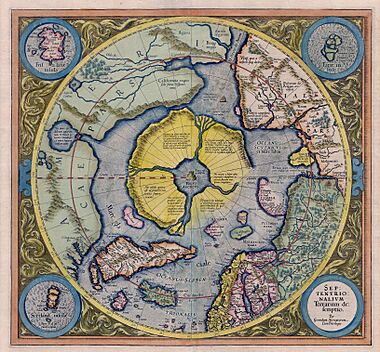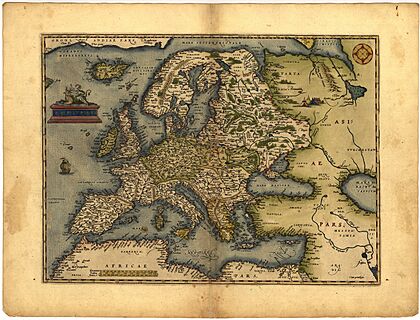Hyperborea facts for kids

The Hyperboreans were a legendary group of people in Greek mythology. They were believed to live in a land far to the north, at the very edge of the known world. Their name, "Hyperboreans," means "beyond Boreas," who was the Greek god of the north wind. This suggests they lived in a place even colder and further north than where Boreas blew.
Even though they lived in a very cold part of the world, the Hyperboreans were thought to live in a sunny, warm, and blessed land. Many stories say they lived north of the Riphean Mountains. These mountains protected them from the cold north wind. The oldest myths say they were special favorites of the god Apollo. Some ancient Greek writers even believed the Hyperboreans founded Apollo's temples in Delos and Delphi. Later, some Greeks thought Hyperborea might be in ancient Libya, near the Atlas Mountains. This area was known for the worship of a sun god, similar to Apollo.
Over time, writers had different ideas about whether the Hyperboreans were real or just a myth. Some thought they were purely imaginary. Others linked them to real people and places in northern Europe, like Great Britain, Scandinavia, or Siberia. In later stories from the Middle Ages and Renaissance, the Hyperboreans became a symbol of faraway, exotic places. Today, experts think the myth combines ideas about perfect societies (utopias), stories about the "edge of the world," the worship of Apollo, and exaggerated tales of things seen in northern Europe, like the midnight sun.
Contents
Early Stories About Hyperborea
Herodotus's Accounts
One of the earliest detailed writings about Hyperborea comes from Herodotus's book Histories, written around 450 BC. Herodotus mentioned that even older writers, like Hesiod and Homer, might have talked about the Hyperboreans. Homer supposedly wrote about them in a lost work called Epigoni.
Herodotus also wrote about a poet named Aristeas from the 7th century BC. Aristeas wrote a poem called Arimaspea (now lost) about a trip to the Issedones, who lived in what is now Kazakh Steppe. Beyond them lived the one-eyed Arimaspians, then gold-guarding griffins, and then the Hyperboreans. Herodotus thought Hyperborea was somewhere in Northeast Asia.
Pindar, a Greek poet from the 5th century BC, also described the Hyperboreans in his poems. He told a story about Perseus's journey to their land. Other Greek writers from that time, like Simonides of Ceos and Hellanicus of Lesbos, also mentioned the Hyperboreans in their works.
Where Was Hyperborea Located?
The Hyperboreans were believed to live beyond the snowy Riphean Mountains. The writer Pausanias said it was "The land of the Hyperboreans, men living beyond the home of Boreas." Homer thought Boreas lived in Thrace, so he believed Hyperborea was north of Thrace, in Dacia. Other writers like Sophocles and Callimachus also placed Boreas in Thrace.
However, other ancient writers had different ideas about where Boreas or the Riphean Mountains were. For example, Hecataeus of Miletus thought the Riphean Mountains were near the Black Sea. Pindar placed Boreas, the Riphean Mountains, and Hyperborea all near the Danube River.
Some writers, like Heraclides Ponticus, even thought the Riphean Mountains were the Alps. They believed the Hyperboreans were a Celtic tribe living just beyond the Alps. Aristotle placed the Riphean mountains on the edge of Scythia, with Hyperborea even further north. Hecataeus of Abdera and others believed Hyperborea was Britain.
Later Roman and Greek writers continued to change the location of these places. But they all agreed that Hyperborea was in the far north of Greece or southern Europe. Some placed it near the Arctic region. Maps based on descriptions from Strabo showed Hyperborea as a peninsula or island beyond what is now France. Other descriptions put it near the Ural Mountains.
Later Classical Accounts
Plutarch, writing in the 1st century AD, connected the Hyperboreans with the Gauls. These were the people who attacked Rome in the 4th century BC.
Writers like Aelian, Diodorus Siculus, and Stephen of Byzantium also wrote about Hyperborea. However, they didn't add many new details.
In the 2nd century AD, the philosopher Hierocles said the Hyperboreans were the same as the Scythians. He also said the Riphean Mountains were the Ural Mountains. Early Christian writers like Clement of Alexandria also made this connection.
Ancient Link to Britain
The idea that Hyperborea was Britain first came from Hecataeus of Abdera in the 4th century BC. A piece of his writing, saved by Diodorus Siculus, says: "Beyond the land of the Celts, there is an island in the ocean, as big as Sicily. This island is in the north and is home to the Hyperboreans. They are called that because their home is beyond where the north wind (Boreas) blows. The island is fertile and grows every crop, and it has a very mild climate."
Hecataeus of Abdera also wrote that the Hyperboreans had a "magnificent sacred precinct of Apollo and a notable temple which is adorned with many votive offerings and is spherical in shape." Some experts believe this temple might have been Stonehenge. However, Diodorus himself did not say Hyperborea was Britain.
Around 90 BC, Pseudo-Scymnus wrote that Boreas lived at the very edge of Gaul (France). He said there was a pillar dedicated to Boreas on the coast. Some think this refers to northern France, and Hyperborea would then be the British Isles, just across the English Channel.
Ptolemy and Marcian of Heraclea both placed Hyperborea in the North Sea, which they called the "Hyperborean Ocean."
In 1726, John Toland specifically said Diodorus's Hyperborea was the Isle of Lewis in Scotland. He thought the spherical temple was the Callanish Stones.
Legends of the Hyperboreans
Along with Thule, Hyperborea was one of the "unknown lands" to the Greeks and Romans. Writers like Pliny, Pindar, Herodotus, Virgil, and Cicero wrote that people there lived to be a thousand years old and were always happy. Hecataeus of Abdera collected all the stories about the Hyperboreans in the 4th century BC.
Legend said that the sun would rise and set only once a year in Hyperborea. This would place it in the Arctic Circle or other polar regions.
The ancient Greek writer Theopompus wrote a strange story in his work Philippica. He claimed that Hyperborea was once going to be attacked by a large army from another island. But the soldiers realized the Hyperboreans were too strong and too blessed to be conquered, so they gave up. This story might have been a comedy or satire.
Theseus was said to have visited the Hyperboreans. Also, Pindar moved the story of Perseus fighting Medusa from its usual location in Libya to Hyperborea.
Apollonius wrote that the Argonauts saw Hyperborea when they sailed through the mythical river Eridanos.
Hyperboreans and the God Apollo
The Greeks believed that Apollo was especially honored by the Hyperboreans. They thought he spent his winters living among them.
According to Herodotus, gifts from the Hyperboreans would travel to Scythia packed in straw. Then, they were passed from one tribe to another until they reached Dodona in Greece. From there, they went to other Greek peoples and finally to Apollo's temple on Delos. Herodotus said they used this method because the first time gifts were brought by two maidens, Hyperoche and Laodice, with five escorts, none of them returned. To prevent this, the Hyperboreans started sending gifts to their borders and asking their neighbors to deliver them.
Herodotus also mentioned two other virgin maidens, Arge and Opis, who came from Hyperborea to Delos even earlier. They came as a tribute to the goddess Ilithyia (who helped with childbirth). The maidens were honored in Delos, where women collected gifts from them and sang hymns.
Abaris the Hyperborean
A famous legendary healer from Hyperborea was named "Abaris" or "Abaris the Healer." Herodotus first wrote about him. Plato thought Abaris was a doctor from the far north. Strabo said Abaris was Scythian, like the early philosopher Anacharsis.
Physical Appearance of Hyperboreans
Greek legends say that the Boreades, who were the children of Boreas and the snow-nymph Chione, founded the first government in Hyperborea. This story is found in the writings of Aelian: "This god [Apollo] has as priests the sons of Boreas [North Wind] and Chione [Snow], three in number, brothers by birth, and six cubits in height [about 2.7 meters or 9 feet tall]."
Diodorus Siculus added to this, saying: "The kings of this (Hyperborean) city and the supervisors of the sacred precinct are called Boreadae, since they are descendants of Boreas, and the succession to these positions is always kept in their family."
So, the Boreades were believed to be giant kings, about 9 feet tall, who ruled Hyperborea. Other ancient writings don't give many details about the Hyperboreans' physical appearance. However, Aelius Herodianus, a grammarian in the 3rd century, wrote that the mythical Arimaspi looked just like the Hyperboreans. Stephanus of Byzantium in the 6th century said the same. The ancient poet Callimachus described the Arimaspi as having fair hair. If the Arimaspi looked like the Hyperboreans, then it's possible the Hyperboreans also had fair hair.
Celts as Hyperboreans
Six classical Greek writers also connected the Hyperboreans with their Celtic neighbors in the north. These included Antimachus of Colophon, Heraclides Ponticus, and Hecataeus of Abdera. The way Greeks understood other peoples was often shaped by how they applied myths of a "Golden Age" to their own time, especially during Greek colonization and trade.
When the mythical Riphean mountains were thought to be the Alps in northern Italy, it made sense to link the Hyperboreans with the Celts living in and beyond the Alps. The Celts' reputation for feasting and loving gold might have also strengthened this connection.
Modern Ideas About Hyperboreans

People in northern Europe, like Scandinavians, sometimes saw themselves as the Hyperboreans when they learned about ancient Greek and Roman culture. This fits with the idea of a constantly sunny land beyond the north, because northern Scandinavia has very long days with no darkness during the summer ("midnight sun"). This idea was very strong in Sweden during the 17th century. Some Swedish thinkers even claimed that Scandinavia was both the lost Atlantis and the Hyperborean land.
Today, the term "Hyperborean" is sometimes used playfully to describe groups of people who live in a cold climate. For example, in library classification systems, "Hyperborean Languages" is a category for all the different languages spoken by people living in Arctic regions, like the Inuit.
The term "Hyperborean" can also mean being distant from ordinary things. The philosopher Friedrich Nietzsche called his understanding readers "Hyperboreans" in his book The Antichrist. He wrote, "Beyond the North, beyond the ice, beyond death – our life, our happiness."
See also
Sources


